The Conquest: The Last Argument of Kings February 2024 update has arrived, bringing with it a slew of balance and rules updates, and an entirely new faction – the Sorcerer Kings. Inspired by Arabic, Turkic and Vedic mythologies, the Goonhammer team is here with a hot take on the look, feel and play of the new army.
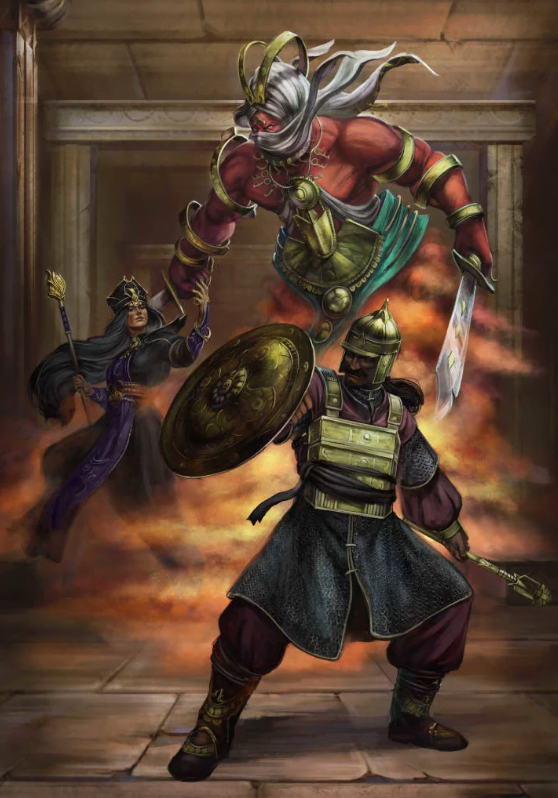
How They Look
General Cross: Fantasy and Science Fiction wargames (read: Game workshop) are often heavily inspired by European or East Asian cultures, with some nods to Mesoamerica and Arabic designs in small amounts. Let’s be honest, we’ve seen enough Templars, Vikings and Mediaeval European armies for a while!
Whilst these are rich inspirations to draw from, there’s something very refreshing about the Sorcerer Kings drawing from the relatively untapped central Asian and Indian culture and style. Even with the initial releases, it’s clear this army is going to be distinct and flavourful especially as we see more of the Elementals releases.
Rob: Coming in hot with absolutely unfuckwithable fashion sense, if you ever played a Wizard faction in literally any Heroes of Might and Magic game, the Sorcerer Kings are for you. At release, the faction offers an impressive selection of majestic wizards, disciplined Ottoman-esque infantry, and mighty elementals. The influences across the existing are clear and crisply executed, although Para Bellum hasn’t been afraid to execute their own vision with models like the truly impressive Rakshasa Ravanar and Bakasuras.
Thanqol: My heart was broken when my colleague decided to pick up our review copies. There’s so much potential for bright, vivid colours with these, I recommend looking at some traditional Indian art for painting inspiration.
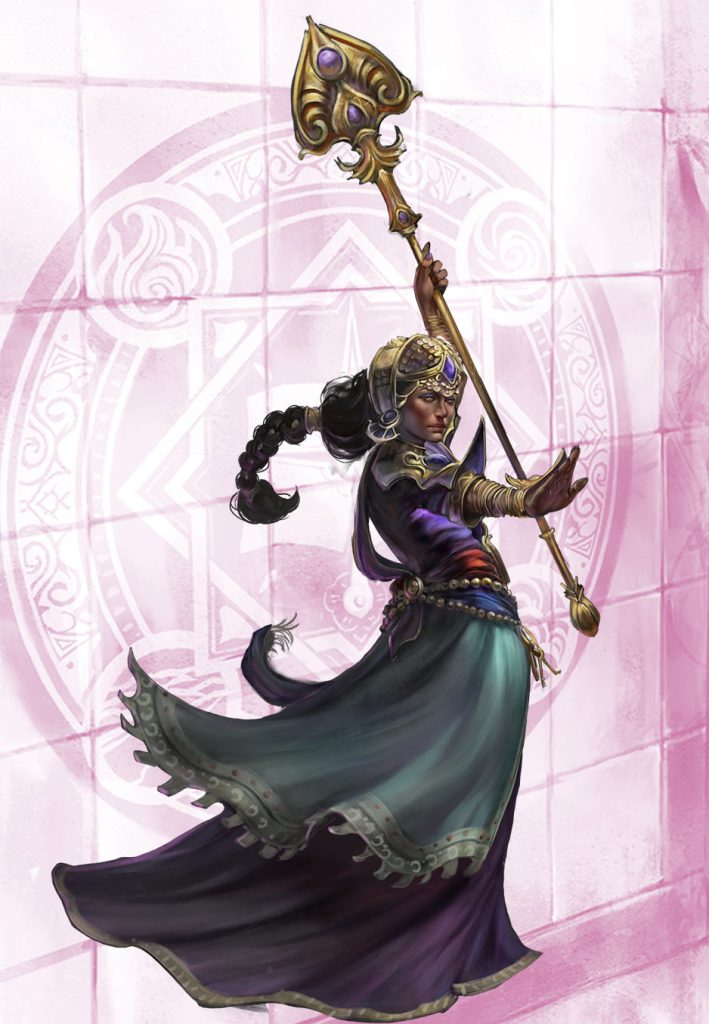
How They Play
Thanqol: As a whole, Sorcerer Kings feel like they’re a Control/Denial faction. On the individual unit level, they’re balanced like Spires. Many units are directly comparable to Spires counterparts – Rajakur, for example, are Bound Clones with +1 Resolve and Hardened instead of Support. That’s solid, but it’s not the raw independent efficiency of a unit of Men at Arms or Raiders for mainstay units in that price bracket. Similarly, Windborne Djinn’s base statline compares unfavourably to Leonine Avatara. Like the Spires, these units are paying a premium just to exist in this faction, and they’re paying that premium because of the weight of weird special rules that are expected to be pumping through them rather than standing on their own merits.
This makes Sorcerer Kings a synergy faction. To achieve battlefield victory you need to be getting the most out of the spells, rituals and special rules you have access to because point for point you’re getting a worse deal than a more straightforward faction. Moreover, with no Support anywhere I can see in the faction so far, the faction is disincentivised from building large powerful units, making it feel like it wants to be composed of small, adaptive threats rather than powerful area holders. It wants to skirmish, win local battles through a sharp application of force, and then – and I think this is key – transition into a game of scoring denial.
Sorcerer Kings have a couple of ways to add extra stands worth of scoring to narrow areas, but my eye immediately goes to Wildfire as the biggest answer to this. You can turn off scoring for an enemy regiment for an entire round – that’s huge. My Sorcerer Kings gameplan would immediately become two Air Sorceresses built around casting this spell, determined to get a toehold on an objective and grind out multiple turns of victory points while my army core comes up to reinforce. It’s a plan that appeals a lot to my Attrition Brain playstyle, but it’s possible that Sorcerer Kings at release don’t have the tools to back it up. The small skirmisher units they’re pushed towards might simply not survive the round to end engaged, the spell being Scaling means that it’s hard to bully large units with countermagic, and of course you need to pair this Air spell with Fire elementals which requires your warbands be structured in a highly specific way. It might make sense to write a battleplan where one objective is repeatedly denied this way while you concentrate force on the other side of the table – it’s a lot to set up, but it still feels like the most eye-catching single ability in the faction.
Also note that, at time of review, the Sorceress’ Supremacy Ability says when a sorceress casts a spell, not when the warlord casts a spell. This I think makes two backline Sorcerers in Archer units, putting spells exactly where they need to go, is an extremely good and correct way to get the most out of this.
The broader spell arsenal has an emphasis on shutting down an opponent’s abilities or inflicting debuffs rather than straightforwards Dweghom style wizard artillery. There are options for shutting down draw events, healing or inflicting Bloodlust to pull a unit out of position. These are all highly technical abilities, often rewarding exact timing and understanding of an opponent’s army, rather than point and click hurt/comfort spells more common elsewhere. Like all control and denial factions, then, Sorcerer Kings players will be strongest if they’re experienced enough to understand the possibilities of their opponent’s army list and how to counter them. Which is to say, I think that if you’re new to Conquest and playing Sorcerer Kings you’re going to have a rough time for a while. It’s going to be a hard army to pilot.

Rob: As Thanqol notes above, Sorcerer Kings have landed as an army that presents a lot of interlocking synergies, which players will need to engineer into their army when writing a list, and go on to execute on that broader plan in play. There’s a lot in the faction to take in, even at release, but the good news here is that you will be able to pick out most of the necessary synergies and themes just by reading and digesting the army rules, and list construction for Sorcerer Kings feels particularly compelling as a result.
Out the gate, I feel like there are three main themes at play that you want to look to incorporate into your lists in some capacity:
- Spellcasting and elemental synergies, which can really add up. I’ll wax lyrical about the ridiculously powerful Jadoo Kavatch artefact below for one common build-around power piece, but there’s a lot of potential force multiplication baked into a lot of the spells, artefacts and special rules. A simple example is casting the Burn to Cinders spell at an enemy unit engaged with some Efreet Sword Dancers, which effectively grants the spell +4 hits (one from the extra success granted by Infernal Branding, and an extra three from the rules of Burn to Cinders). Even though Sorcerer Kings aren’t a blasty faction like Dweghom, lining this combination up makes the spell way stronger offensively than it looks at first glance and represents some pretty serious magical oomph.
- Objective control themes. There’s definitely a strong objective focus for the faction baked into their rules and gameplay, although I fear this may not bear out easily in play. Conquest is too lethal a game and manoeuvre has too much decisive potential for the platonic ideal of a tightly contested struggle over objectives to actually materialise often – decisive control is much more common, one way or another. Still, there are enough small, cumulative rules available to Sorcerer Kings to comprise at least an element of a broader list and game plan, which is quite compelling. And as Thanqol notes above, Wildfire alone has a lot of potential even if your opponent has locked you out of entering a scenario zone.
- Sorcerer kings will be playing the long game most turns. Because their command stack is likely to be thick with rituals alongside their actual cards, it will be common to see 13-15 ‘activation’ stacks even from 10-11 unit and character armies, which means sorcerer kings will often be enduring early aggression from their opponent in order to set up powerful combination plays later in the turn. There are downsides here – they’ll often be disadvantaged on the supremacy roll, and then be asked to give up further tempo during the turn by resolving ritual effects in place of unit activations. But if you can use rules like the healing from Born of Fire/Air and your generally resilient and cost-effective infantry to weather the storm, I can see a lot of Sorcerer Kings turns ending with the brutal combination of multiple ritual into Elemental unit activations (for example, Incite Rage -> Elemental Unit activates -> Sayf or Conflagration -> Elemental Unit activates as your last four activations).
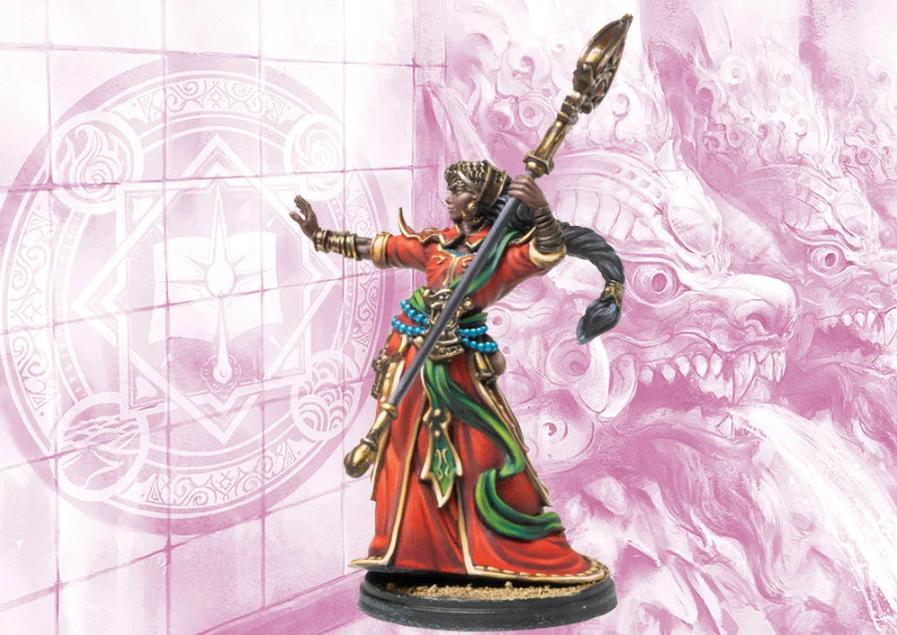
What stands out?
Rob: although there are a lot of compelling units and items in the factions, I’ve highlighted a number of the pieces that leapt off the page to me, either mechanically or thematically. There are some very interesting options available here.
Rituals
For the rituals, Far Sight is a standout winner for me (it’s the only ritual that doesn’t require you to give up tempo during a heavily engaged turn) and something I would generally try to have available on the regular. However, all the rituals feel interesting and playable, and the more niche ones can be selected for more niche situations, since you can easily have access to most or all of them in any given list.
The Ritual mechanic generally is extremely cool and with a ton of promise but also the root cause of my one major critique of the faction, which I’ll discuss at the end of the article.
Artefacts and Masteries
There are a lot of compelling artefacts and masteries, but I have my eye on a few in particular as real contenders:
- Jadoo Kavatch is probably the most powerful build-around artefact in the faction and offers an eye-watering amount of potential value. At only 30pts, it can potentially give an entire army the ability to reroll 6s to hit for the entire game, without especially complicated setup (remember, it’s quite easy to give Born of Air or Born of Flame to human regiments thanks to spellcasting characters imparting either or both of these rules). The only thing potentially keeping this artefact in check is that the powerful Wildfire spell relies on cross-court synergy, whereas the Jadoo Kavatch wants you to go all-in on one court or the other.
- Dancing scimitar is probably my favourite artefact in the game to date in terms of mechanics embodying a theme. It’s good, very flexible, and super cool to use – and incidentally plays well into the Sorcerer Kings scenario game. 10/10, will magically animate and unleash upon my enemies at every opportunity.
- Parivartan (which lets you exchange rituals for free spellcasting actions) and the Banner of Elemental Dominance (which exchanges bloodlust for unstoppable on Elemental units) might both end up being quite important in terms of adding flexibility to Sorcerer Kings gameplay. It isn’t necessarily easy to fit either or both of them in, but if you can, they mitigate different weaknesses of the army and offer a lot of potential flexibility. I expect to see the banner especially be popular in early Sorcerer Kings armies.
Units
- Ghols almost certainly going to be a contentious unit on release. They’re very fragile and not actually terribly dangerous thanks to a clash of only 1, but native vanguard+unstoppable on a march 6 regiment forgives a lot, especially with bloodlust+vanguard synergy on top (meaning they can march onto the table, charge and clash all in the same activation). I think these are initially going to be written off as awful, but may come into their own in the hands of experienced players who are able to set up that march->charge->clash off a reinforcement line into an enemy flank. Of course, to do that you need something to set a reinforcement line, which right now means… Ghols. Hmm.
- The human infantry is some of the best-in-game mainstay of any faction. I disagree with Thanqol’s take above about the native quality of Rajukar infantry; I think they’re excellent, and Dhanudarva Archers are even better, being basically cheaper, mainstay marksmen clones with only a small range disadvantage that they make up for with speed and durability. Between Dhanudarva and Rajukar, the human side of the enclaves is very nearly elite at a very affordable price. If anything edges the Dhanudarva Archers out of massed play it will only be that Sorcerer Kings have multiple good ranged brute units, which can sit behind the walls of durable infantry and take full advantage of their height to shoot cleanly over the intervening troops.
- Thematically and mechanically, I love the Mahut. The Lord of the Rings miniature wargame endowed a deep and enduring love in me for archers in a howdah on the back of an elephant, and the Mahut looks very solid for cost without actually being an exorbitant centrepiece that sucks air away from the army around it. It’s my kind of model – solid, durable and consistently useful at an attractive price, it’s powerful without being a deathstar. Para Bellum seems to have learned some lessons from the Tontorr here and not condensed nearly a quarter of an army’s power onto a single 110mm a side square base, and I’m here for it.
Thanqol: For me, it’s the Raj that earns the place of most fascinating piece in the list. They’re good in melee, has a wide range of excellent spells, has both Fire and Air elemental affinities for them and their unit which opens up an array of synergistic options and has an extremely good and reliable Supremacy ability. They’re so good that you’re likely to forget that they’re only 4 wounds and therefore stands really good odds of dying in any given duel.
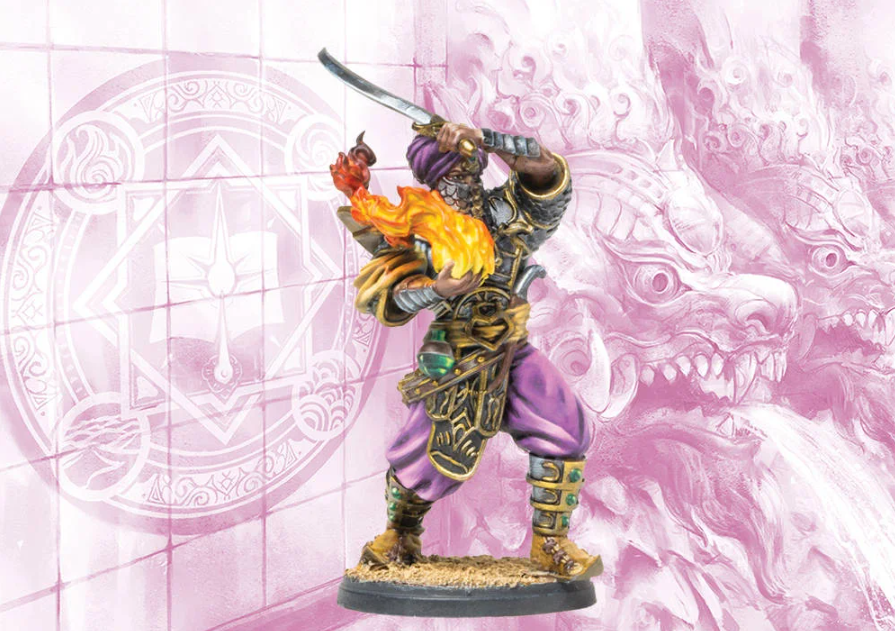
Our one critique (the Mahut in the room) – Ritual Timekeeping
Rob: To date, I’ve played one game with Sorcerer Kings, and I had such a violent negative reaction to the ritual mechanic once I began playing with it that it prompted me to go away and spend quite a bit of time thinking about why that might be so before I returned to the faction.
The conclusion I came to was that my negative response is mostly a personal one, but it’s also one I’m not likely to get past. When I play wargames, it’s a flow state experience. However, the ritual mechanic asks me to interrupt that to perform several small administrative tasks (adding a token, counting the number of tokens remaining, comparing it against the time value of the ritual) for each of the two or three rituals I have counting down, every single time one of my units activates.
Individually, no specific action was burdensome, but collectively this administrative busywork was impossible to perform in a way that maintained the flow state of the game. While I’m sure it could become at least somewhat second nature with a combination of practice and some mechanical aid (more thoughts on this below), as far as initial experiences go I don’t think I’ve ever experienced a stronger sense of emotional friction with any new army, in any game I’ve ever played.
Something that adds to this frustration is that the administrative burden of the Ritual mechanic does not feel necessary, because all the granularity of counting down the ritual doesn’t result in meaningful granularity in terms of when a ritual resolves. It will either resolve the turn it begins, or (more commonly) one turn after it begins, or occasionally two turns after it begins (theoretically it could take longer, but I didn’t have a ritual that I actually cared about resolve in more than two turns even early in the game), and once resolved it goes into the command stack the next turn to be resolved at a time of your choosing. The number of steps necessary to reach one of only a two or three different outcomes feels like mechanical smoke and mirrors to make you feel like you’re experiencing progress when the actual outcome was set the moment you ordered your command stack on the turn you intended to commence the ritual.
If you’re a player interested in the Sorcerer Kings and think this an issue you might stumble on as well, my advice is firstly to commit to some practice with them (because it is very likely that practice will mitigate some of this effect) and secondly to invest in some high-quality game aids. Something like dials is a possibility that I’d recommend for many players (for example – and this is not a sponsored link, just a product we think is neat – Sewn Geekery sell a number of conquest game aids on their etsy store and have plans for Ritual dials specifically for Sorcerer Kings). For me personally, though, I’d look to find some nice high-quality polished stone or wooden tokens and little containers to move them around in (or even something like an abacus) with the intention of making the tracking of ritual progress a pleasant tactile experience. Your mileage may vary on this one, but you’re going to be tic-tacking counters or turning dials a lot as sorcerer kings, so you need to find a way to enjoy that. If you do, though, the faction has a hell of a lot to offer.
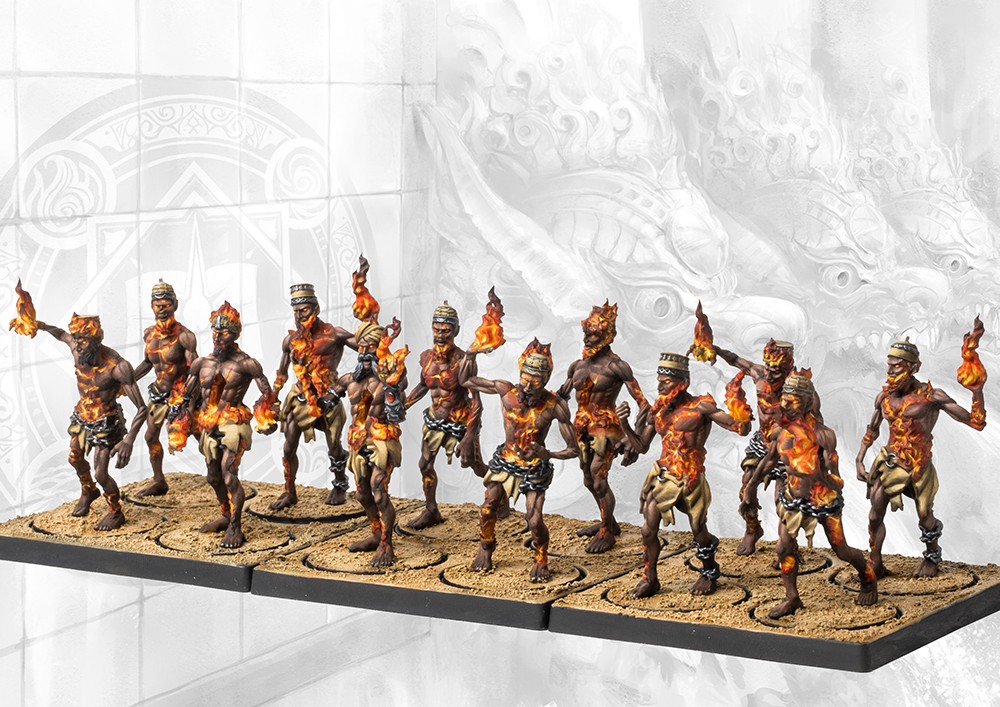
As always if you want to get 10% off and support Goonhammer you can make your Conquest purchase by clicking here for US/Canada or here for EU/rest of world. You’ll also need to enter code “goonhammer” at checkout. Look, we don’t make the rules, that’s just how it works!
Have any questions or feedback? Drop us a note in the comments below or email us at contact@goonhammer.com.



You must be logged in to post a comment.